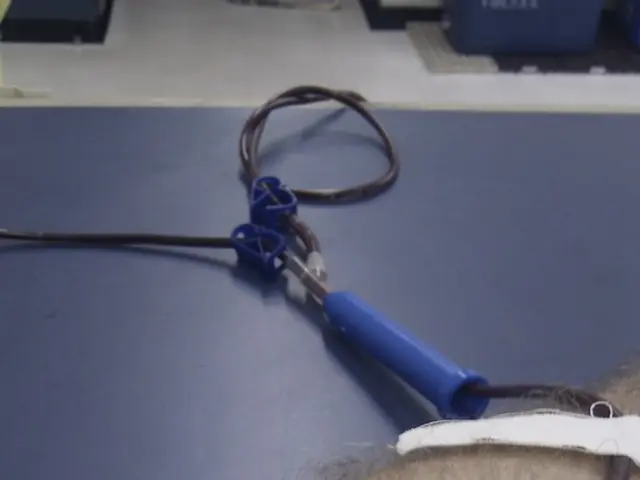Anticipated Recovery Process after Hip Replacement Surgery: Understanding the Course of Healing
Hip Replacement Recovery: A Comprehensive Guide
Recovery timelines for individuals undergoing hip replacement surgery can vary, but most patients can engage in light activities within three to six weeks post-surgery. The success of the recovery process is influenced by several factors, including pre-surgical preparations and adherence to prescribed rehabilitation protocols.
Preparing for Surgery
To ensure smooth recovery, it is essential to prepare the body several weeks before the surgery. This reduces the risk of complications and facilitates a speedier recovery. Both partial and total hip replacements require the same pre-surgical steps. These include consulting with doctors, engaging in leg, core, and upper body exercises, maintaining a moderate weight, quitting smoking, arranging for post-surgical assistance, preparing meals ahead of time, and modifying the home environment for convenience and accessibility.
Early Recovery and Hospital Stay
Following surgery, patients may remain in the hospital for one to two days, with some being discharged on the same day. As soon as possible after the operation, medical professionals encourage patients to get up and move around, starting with short walks with assistance. They may also instruct the use of painkillers, such as opioids, local anesthetic, nonsteroidal anti-inflammatory drugs (NSAIDs), acetaminophen, or a combination. The surgical incision will be stapled or sutured and may require home wound care, which will be discussed by the medical team.
Returning Home and Physical Therapy
In the weeks following the return home, patients may require assistance with everyday tasks for several weeks or may need to stay in a rehabilitation facility. Pain and discomfort can persist for a few weeks, necessitating the continued use of prescription medications. Physical therapy is crucial during this period, as it helps build strength and flexibility and speeds recovery. Daily exercises designed to improve flexibility and strength in the new joint are recommended. Home health aides, nurses, or physical therapists may provide support and assistance with recovery.
Recovery Milestones
By the tenth to fourteenth day post-surgery, stitches are usually removed, and pain and swelling may begin to decrease, albeit at varying rates among individuals. Patients who previously relied on canes or walkers may still require these devices during the early stages of recovery. Within three to six weeks, many patients can undertake light activities of daily living, feel stronger and more stable, and perform basic self-care tasks.
Returning to Work and Activities
Six weeks post-surgery is often the time when patients feel ready to return to work, although this can vary. After six to eight weeks, individuals may safely engage in sexual activities once more. Continuous physical therapy is advised for at least two months post-surgery, during which time patients can consult their doctors about resume additional exercise, such as swimming and walking.
Long-Term Recovery and Maintenance
By the three-month mark, most patients can resume normal daily activities, with the need to reduce or stop physical therapy depending on their doctor's recommendations. athletes can typically return to their preferred sports after a few months, provided they receive medical clearance.
Recovery Tips and Precautions
Patients can maximize their recovery by following physical therapy exercises as directed, engaging in gentle exercises, such as daily walking, sitting in a reclining position, using cold compresses to reduce swelling, taking prescribed medications as instructed, and utilizing walking aids like crutches if necessary. Restricted activities to avoid include sitting still for extended periods, crossing the legs at the knee, bending the hip more than 90 degrees, bending down to touch the feet or ankles, sitting in low chairs, intense exercise, moving or lifting heavy objects, and activities that may involve jumping or abrupt turns.
• follow physical therapy exercises as a physical therapist instructs• try other gentle exercises, such as daily walking• sit in a reclining position• use a cold compress to reduce swelling• take any prescription medications as a doctor instructs• use walking aids, such as crutches, if necessary
Recovery Differences in Older and Younger Individuals
Traditionally, hip replacements were not recommended for individuals under the age of 20 due to less favorable results. However, in cases of osteonecrosis of the femoral head, where the femoral head collapses, younger patients may require total hip replacements. These cases can yield positive outcomes, offering pain relief and improved functionality. Modern hip replacement implants are leading to better outcomes and survival rates in younger populations.
Recovering older adults should prioritize avoiding falls, especially in the weeks following surgery. They may benefit from using walking aids, such as walkers, crutches, or canes, until they are stable. Recovery may be more challenging for older adults due to existing mobility issues, which may necessitate permanent assistance.
• sitting still for long periods• crossing the legs at the knee• bending the hip more than 90 degrees• bending down to touch the feet or ankles• sitting in low chairs• intense exercise, which may involve jumping or sudden turns• moving or lifting heavy objects
In summary, hip replacement and resurfacing surgeries have similar outcomes and high success rates. Patients can begin recovering the same day as the surgery and are typically able to walk a short distance with assistance soon afterward. Early mobilization, physical therapy, and adherence to rehabilitation protocols are essential in achieving a smooth and successful recovery.
- Pre-surgical preparations, such as consulting with doctors, leg, core, and upper body exercises, maintaining a moderate weight, quitting smoking, arranging for post-surgical assistance, preparing meals ahead of time, and modifying the home environment for convenience and accessibility, are crucial for smooth hip replacement recovery.
- Medical professionals encourage patients to engage in light activities within three to six weeks post-surgery, but prescription medications may still be necessary for pain and discomfort.
- Physical therapy is essential for building strength and flexibility during the recovery period, and daily exercises designed to improve flexibility and strength in the new joint are recommended.
- Gradual decreases in pain and swelling may begin by the tenth to fourteenth day post-surgery, and patients who previously relied on canes or walkers may still require these devices during the early stages of recovery.
- By the three-month mark, most patients can resume normal daily activities and athletes can typically return to their preferred sports after a few months, provided they receive medical clearance.
- To maximize recovery, patients should follow physical therapy exercises as directed, engage in gentle exercises like daily walking, sit in a reclining position, use cold compresses to reduce swelling, take prescribed medications as instructed, and utilize walking aids like crutches if necessary.
- Recovery may be more challenging for older adults due to existing mobility issues, which may necessitate permanent assistance; older individuals should prioritize avoiding falls and use walking aids, such as walkers, crutches, or canes, until they are stable.
- Modern hip replacement implants are leading to better outcomes and survival rates in younger populations, although traditionally, hip replacements were not recommended for individuals under the age of 20.
- In cases of osteonecrosis of the femoral head, where the femoral head collapses, younger patients may require total hip replacements and can yield positive outcomes, offering pain relief and improved functionality. Incorporating various therapies and treatments such as nutrition, cbd, mental-health, fitness-and-exercise, therapies-and-treatments, science, health-and-wellness, chronic-kidney-disease, COPD, ulcerative colitis, Alzheimer's, obesity, predictive, and chronic-diseases into the pre and post-surgery care can further improve the recovery process and overall outcomes for patients undergoing hip replacement surgery.








